What is it about brands that make us feel like they’re part of our lives?
We don’t just buy, like and adopt these brands.
We actually feel connected to them in a way that feels eerily human.
Some brands are so embedded in our lives, we show them genuine human affection, loyalty and in some cases love.
Seriously, Love… Even though it’s just an entity of processes and systems.
What is this mystical power the most loved brands in the world have over us?
The Answer? Brand Personality.
In this article, we’ll break down exactly how you can use this modern brand strategy to warm the hearts of your audience to build long-lasting customer relationships.
Contents

CHAPTER 1

CHAPTER 2
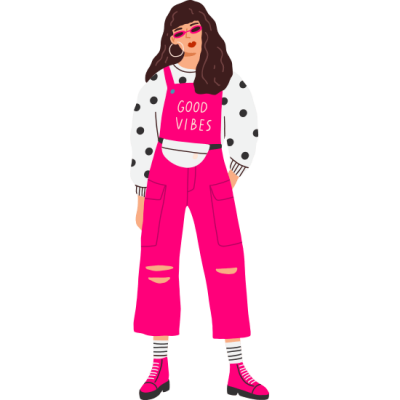
CHAPTER 3
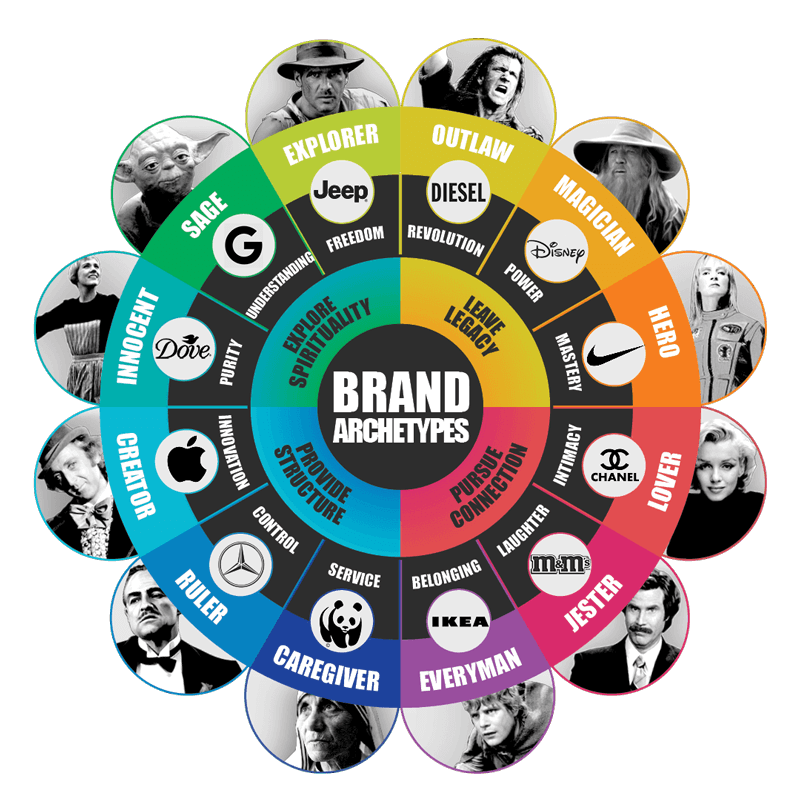
CHAPTER 4

CHAPTER 5

CHAPTER 6
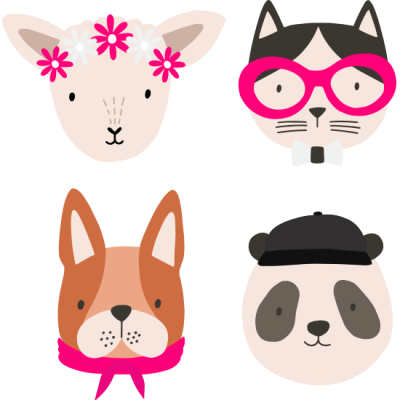
CHAPTER 7

CHAPTER 8
Chapter #1
The Rise Of Brand Personality
Modern brands are beginning to understand the critical importance of a human brand personality.
We no longer accept brands speaking to us as a corporate entity dictating terms.
We demand more and if we don’t feel heard we wield our power by taking our business elsewhere.
In this chapter, you’ll learn why personality has become an increasing important strategic branding tool.

Consumers Demand Brands With Personality
In a Strategy Study by Accenture, they found that as much as 83% of customers demanded more human interaction.
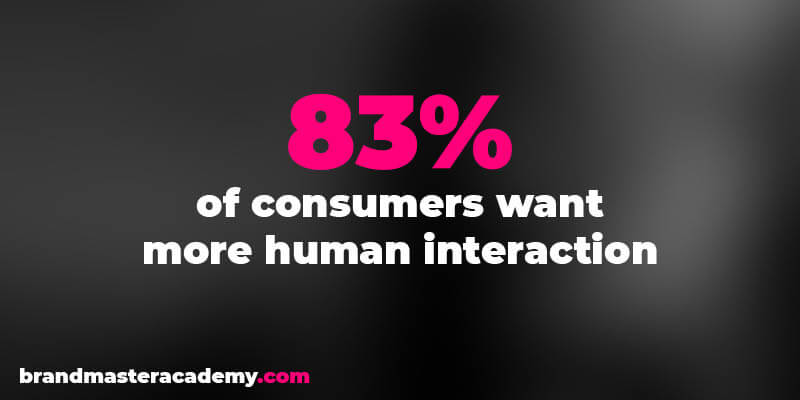
If you go to market with a personality like a wet fish, expect the market to spit you back out as such.
Show up with traits and characteristics your audience is attracted to, however, and you’ll be welcomed in with open arms, a cup of tea and a pair of slippers.
Brand Personality Definition
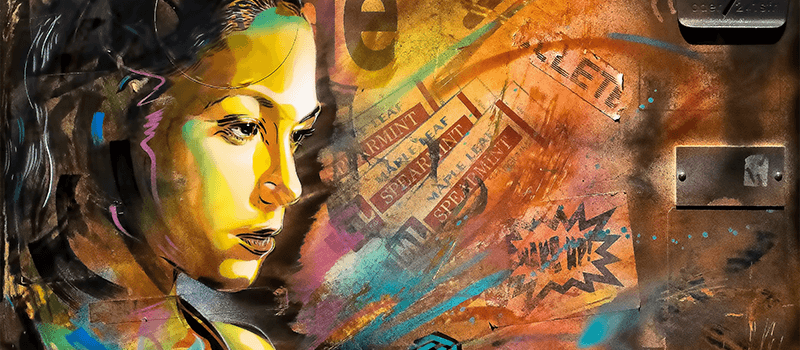
When it comes to defining brand personality, this is what Investopedia has to say.
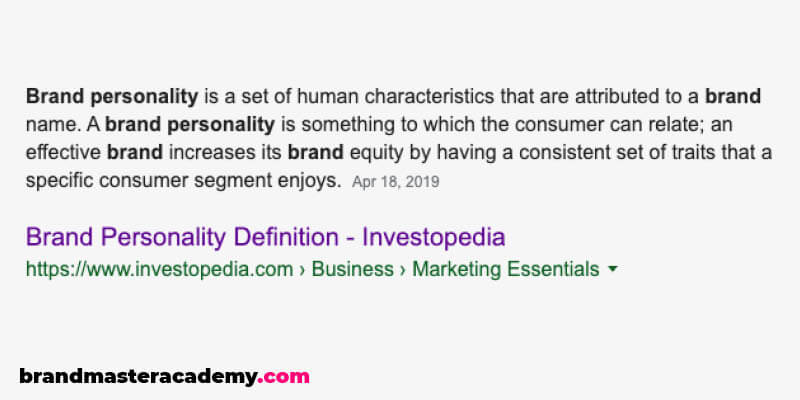
While I agree with some of the above, I would define brand personality in the following way
Brand personality is the collection of traits and characteristics used consistently throughout the entire brand experience to better appeal to and resonate with its intended audience.
Brand personality is about familiarity.
If you can display characteristics that feel familiar or attractive to your audience, you’ll make a connection.
It will warm their stance to your brand message and open up an opportunity to connect with them on a human level.
PRO Brand Strategy BluePrint
Build Brands Like A Pro Brand Strategist

What Is Brand Personality?

Well, it’s a strategic tool used to bring a brand and its intended audience closer together.
It’s developed within the brand strategy from an intimate understanding of who the brand’s target audience is, the personality traits they display more importantly, the characteristics they’re attracted to.
As this study by the University Of Cambridge found, by understanding your audience’s personality and then tailoring your messaging to resonate, brands are more likely to drive actions and thus make connections.
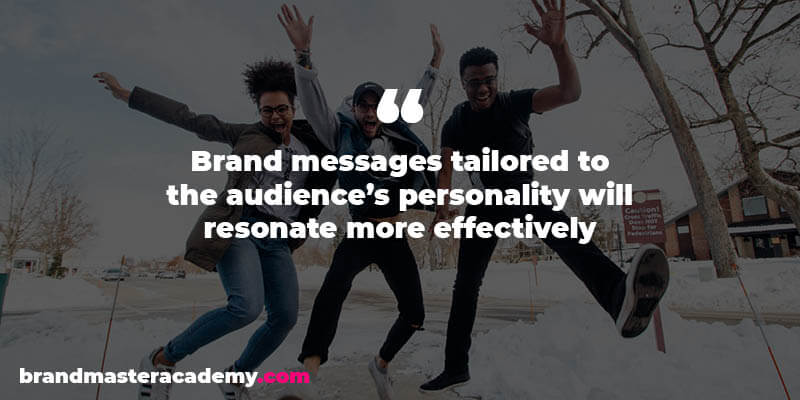
As people we‘re all individuals with individual personalities, characteristics and traits.
But we can also be categorised into groups of people that share the same or similar traits, which can lead to similar behaviours.
“Personality traits can serve as relatively stable predictors of success”
Essentially, if we understand our audience’s personality traits and how they behave, we can understand characteristics likely to shape their behaviour.
Modern brands are now beginning to understand the influence of personality in shaping their audience’s perceptions.
Explore Brand Strategy
Programs & Tools
Brand Authenticity And Personality

We can’t dive deep into developing a personality until we discuss the important role of authenticity.
Without authenticity, any characteristics or personality trait will work against us as a brand or as a person.
This infographic by Marketing Week, ranks brands based on their level of authenticity.
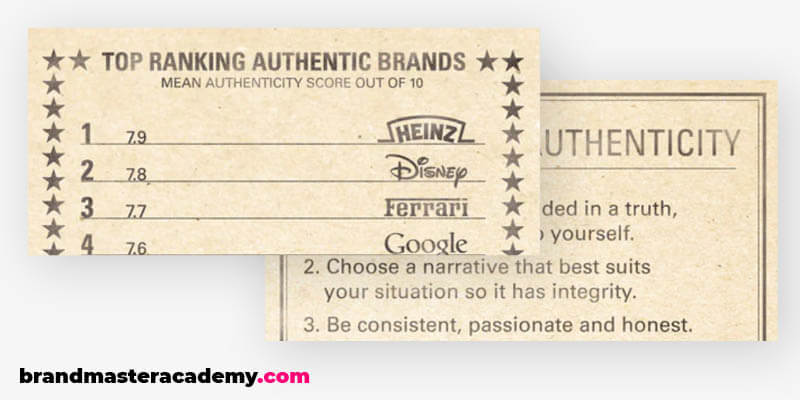
The existence or absence of authenticity is based on “how we feel” about the information that’s coming our way.
This innate feeling is very primitive and instinctual but it’s also highly effective as it stems from our primitive survival instinct.
If we feel that someone is “genuine” or “authentic”, we believe they’re not hiding anything from us, therefore pose no threat.
If on the other hand we sense an absence of authenticity, our instinct for danger kicks into overdrive and our “fight or flight” instinct takes over.
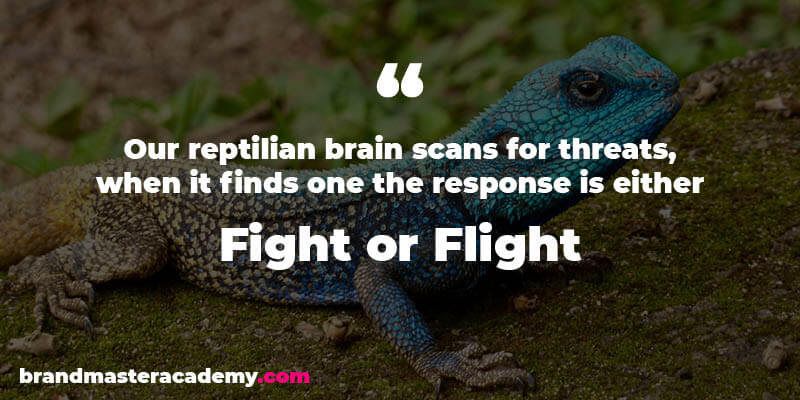
So, what does this mean?
Well, the easiest way to put it is
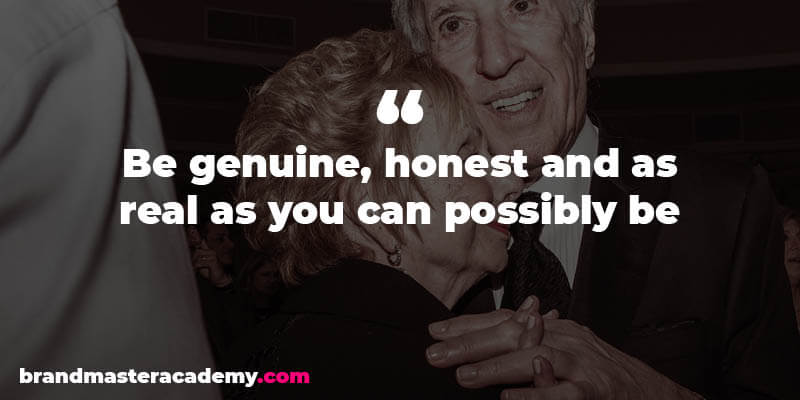
“be genuine, honest and as real as you can possibly be”.
If you take the time to develop a personality for your brand, then ensure that the messages that personality carries are truthful, transparent and sincere.
Personality Is For Humans And Brands

When we connect with our friends and colleagues, we do that though our personality,
But what exactly is our personality?
Well it’s defined as
The combination of characteristics or qualities that form an individual’s distinct character.
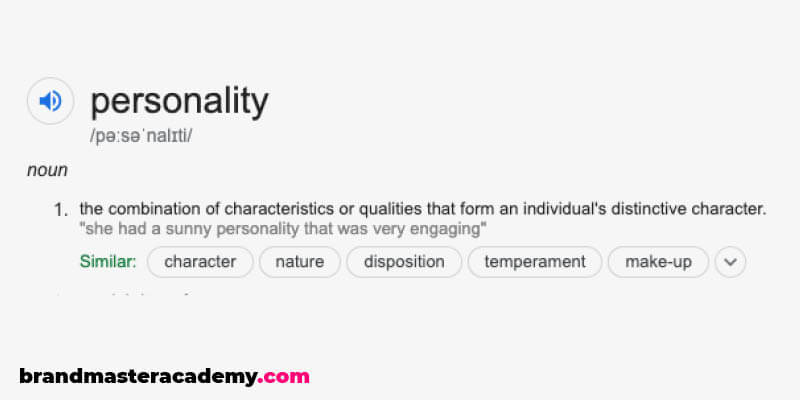
In other words, it’s the make up characteristics, traits and qualities that all come together in how we behave.
Let’s take a look at some characteristics a person might display.
Loyalty
Patience
Optimism
Pessimism
Generosity
Greed
Charm
Confidence
Efficiency
Decisiveness
Motivation
Passiveness
These characteristics are just a drop in the ocean.
Some will represent you more than others, but across the board, the characteristics that represent who you are, all come together to make up your unique personality.
Let’s put this into context for a second.
Have you ever met someone who you just “clicked” with?
Well chances are, you had some characteristics they were attracted to and vice versa.
This is an “alignment of personalities” and it’s how we connect as people.
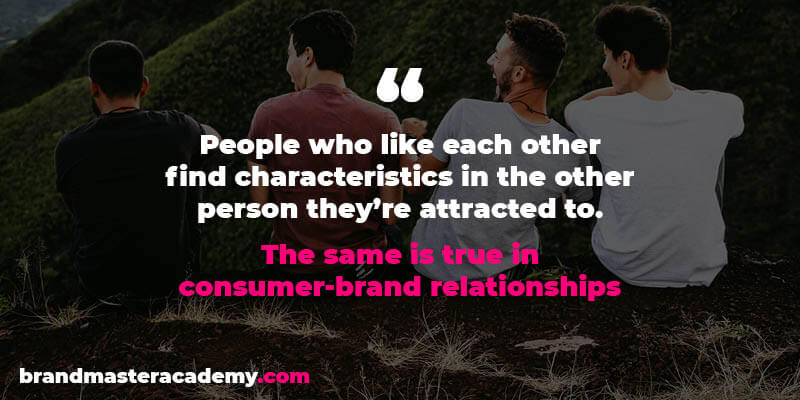
We subconsciously analyse behaviours and actions and through our experience, we decide whether or not we like a person or a brand.
For the most part, this happens on a subconscious level but the decision has a lasting impact on how we see them.
According to a fella by the name of Sigmund Freud, there are three levels to our consciousness, which are the following:
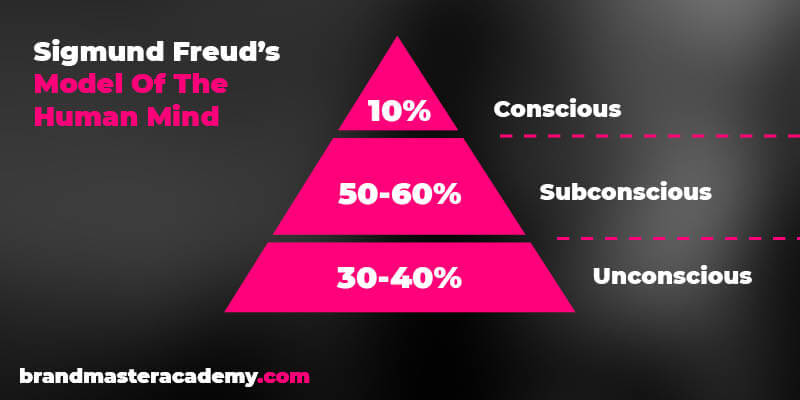
He surmised that the conscious mind only makes up 10%.
The subconscious and unconscious mind make up 90% and this is where we store our memories and experiences and it’s also where we make the lions share of our decisions.
How To Develop A Brand Personality [6-Step Framework]
One-click subscribe for video updates
Brand Personality Is An Ancient Strategy
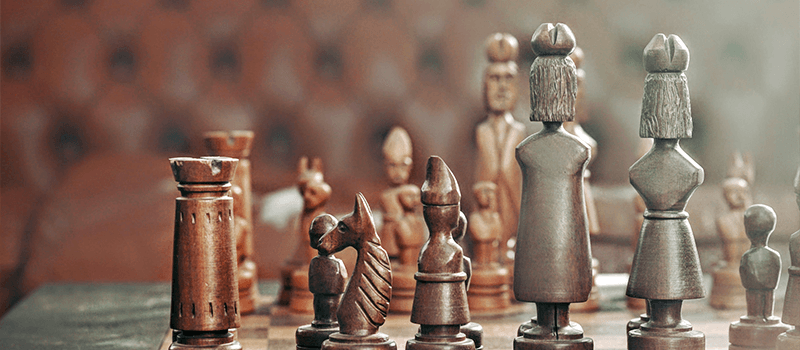
Applying a personality to a brand is not new.
In fact, since the days of business in Babylon, it played a major role on the success of businesses and their competitors.
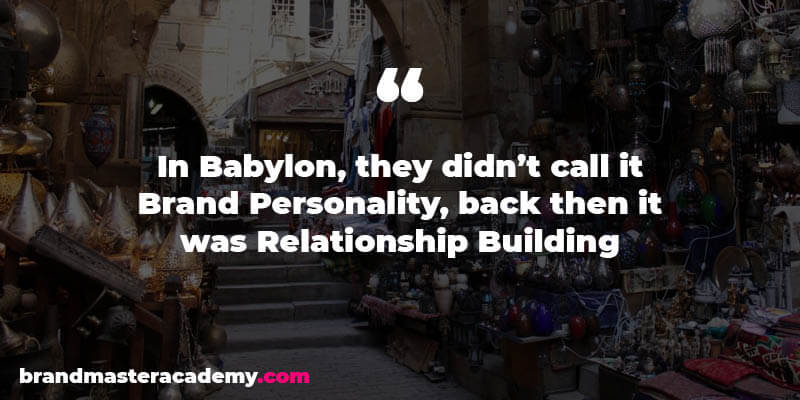
Back then they didn’t call it “brand personality”, they simply called it “relationship building”.
You see, long before the internet and globalisation, most business was done face to face and how a person “behaved” and the “characteristics” they displayed, played an influential role on the success of their business.
Back then the most “likeable” business owners and the ones with the biggest “personalities” also had the most successful businesses.
When the world became globalised, conversations moved to the phone and when the Internet came along, business changed forever.
The art of face-to-face relationship building from business owner to customer was lost.
Consumer Power Evoked Personality

When the Millennial generation came of age, they were armed with something no consumer that came before them could ever compete with.
They had a powerful platform through the internet and social media and they had a voice that demanded attention.
Their power in numbers had brands standing to attention.
Brands that lagged behind or didn’t adjust to this shift in power quick enough, were left behind for brands that listened.

This was a new world.
Consumers wanted to be heard and brands needed to adapt to engage on the digital stage.
Brands that adapted quickest, learned that they needed to engage their audience on a human level and the best way to do that was to adopt human characteristics.
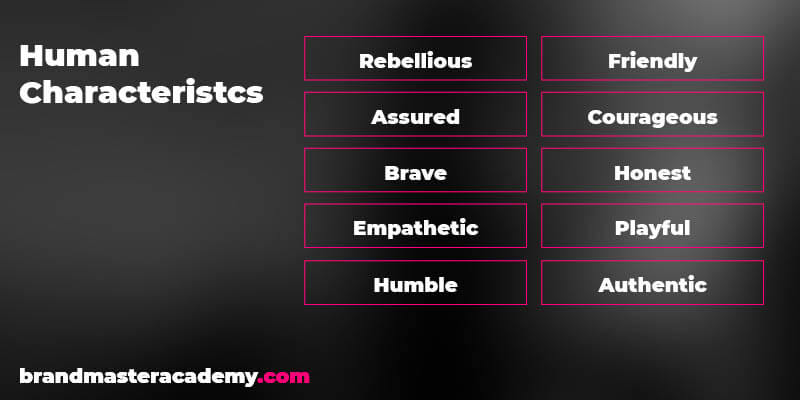
After a long absence, brand personality was born again and today, brands without one sit in the corner without even a glance.
Chapter #2
The Science And Psychology Of Personality
Personality psychology is the study of how our personalities develop and how they influence the way we think and behave.
The art of branding aims to shape perceptions so the audience sees the brand in a certain way.
Brand strategists, who have an understanding of personality psychology, have a distinct advantage when developing a brand personality to shape the way the audience thinks and behaves.
So let’s put on our lab coats and dive in shall we?

Why We Show Brands Human Affection

Our relationships with businesses are purely transactional.
They give us a product or service we need or want and in exchange we gave them money.
When it comes to brands however, the relationship can be entirely different.
In some cases we feel some of the strongest human emotions such as loyalty and love.
But why is this?
They just serve a purpose or fill a gap on the condition that we put our hand in our pocket right?
If we had a friend who acted the same it wouldn’t take us long to cast them out.

You see the most loved brands separate the transaction and the relationship, which allows feelings of affection to grow.
NetBase is an award-winning social media analytics platform that monitors (amongst other things) expressions of affection towards brands.
Their “Love List” has Lego sitting in position #3 with 280,314 expressions of love.
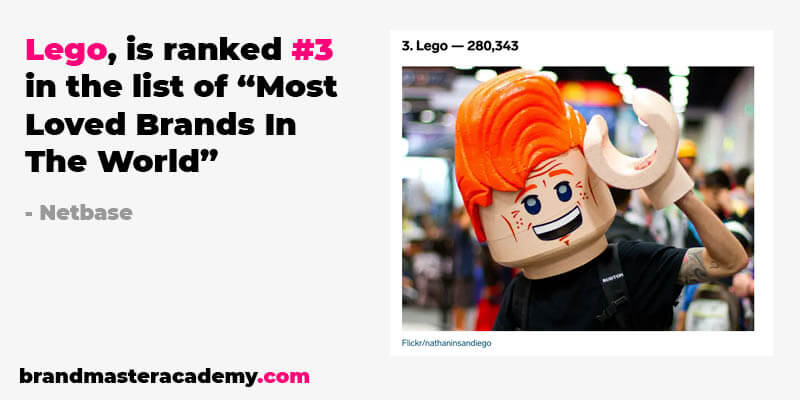
Here’s Business insiders breakdown
When you hear the brand name “Lego”, it suddenly makes sense.
Brands supersede businesses and our relationships with them become far more than transactional.
We bring them into our lives and in some cases, we give them our highest level of affection.
Almost all of these brands share a similar trait in that they display characteristics that align with what we’re attracted to, what we believe or who we are.
Why Certain Personalities Attract Us

When you think of a certain type of person that you’re attracted to, do you think about physical attributes or about characteristics?
OK, well it may depend on the mood you’re in at a given time.
But if we were to remove the power of lust and physical attributes, we’d be left with the persons characteristics and behaviours.
How they speak, what they speak about, their voice their tone, their passions, desires and drives.
Some say love is mysterious, but according to science, attraction is not.
Science has an answer for why we’re attracted to certain people and not to others.

In a scientific study on physical attractiveness participants were asked to rate photos of strangers for their attractiveness.
They were then asked to rate the same photos, only this time with personality descriptions underneath.
The photos that described positive characteristics received the highest score for attractiveness suggesting how influential personality traits are in our attraction.
Our genes, upbringing and experiences all influence what we’re attracted to and certain characteristics evoke some desires more than others.
This explains why someone with a rebellious streak would be attracted to someone who is seen as dangerous.
Our Instinctive Brain Makes The Decisions

Most of us see ourselves as relatively smart people.
I did say relatively.
I don’t see myself as the smartest person in the room, but I don’t see myself as the first to have the wool puled over my eyes either.
Although we believe that we make decisions based on hard facts, figures and logic that we masterfully analyse but that’s not necessarily.
Gerald Zaltman, Havard Business Professor said
“95% of our buying decisions are made in our subconscious mind”.
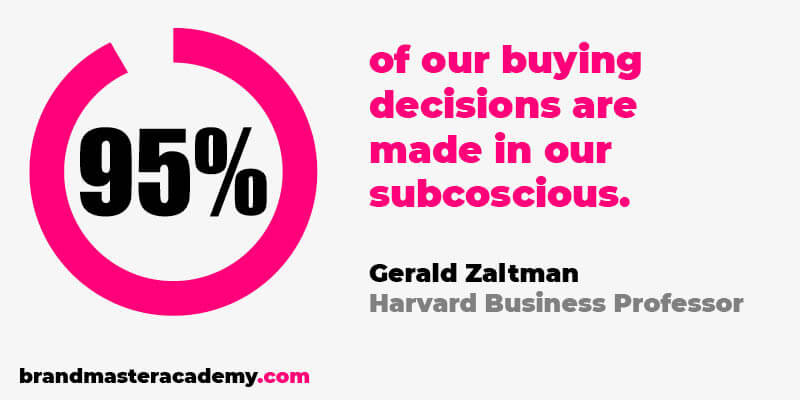
This means that long before we get to the buying decisions, our subconscious mind is hard at work monitoring the situation and making a decision on our behalf.
But how does it make that decision and what is it based on?
Our reptilian brain is the oldest part of the brain that’s designed to keep us alive.
It’s constantly analysing for threats and dangers and operates on a primitive and simplistic level.
This part of the brain existed long before the analytical part and holds sway in the decision making process.
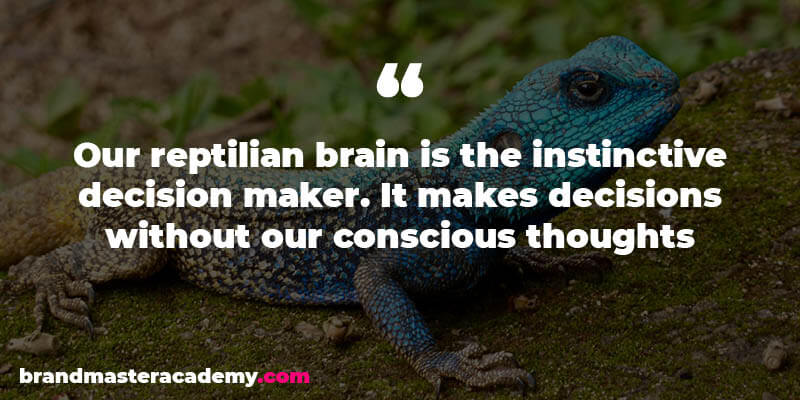
Personality traits and characteristics can represent threats and dangers so when we meet someone new, we know quite quickly whether their personality aligns with ours or not.
So while we may be analysing features and benefits through our analytical brain, chances are our primitive brain has already made the call on the decision we will ultimately make.
Chapter #3
Personality Builds Modern Brands
There are some basics when it comes to building a brand.
There must be an audience with a need or want and a solution they value to meet it.
Once those boxes have been ticked, the strategic elements of the brand take centre stage.
“What” the brand communicates through its message has always been important.
But “How” the brand communicates its message has taken on increased significance in recent years.
Brands that get this right make connections their competitors can’t compete with.

Our Relationships With Brands Are Human

The shift in consumer power was the catalyst for the brand consumer relationship we see today.
Let’s be clear.
This relationship when compared to the brand-consumer relationship of 20 years ago is the difference between night and day.
In fact, they’re more human than they’ve ever been and that trajectory is in an upward trend.
The millennial snatched the power from the hands of brands but the Gen Z’s and the generations to follow, have increasing influence on brand behaviour.
Mckinsey’s breakdown highlights the behaviours of the new generation.
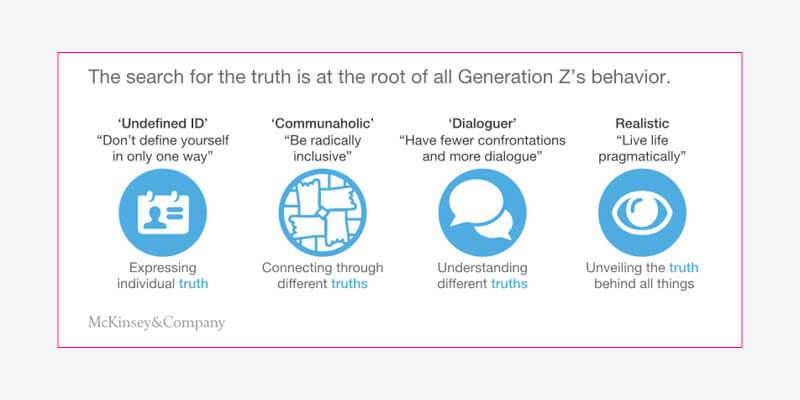
Before the Internet came along, consumers had no voice.
Brands dictated and operated on their own terms.
If the consumer didn’t like it, well, they didn’t have a voice loud enough for anyone to hear.
Today, it’s a different ball game.

When this was all new, brands were fumbling around like a 14-year old with a bra strap not knowing what they should do.
The modern brands however have learned the game, they know the rules and some are navigating them masterfully.
When KFC hit a major problem (eh, a chicken joint running out of chicken?), they masterfully addressed the situation in the same way any human in the same situation would have done.
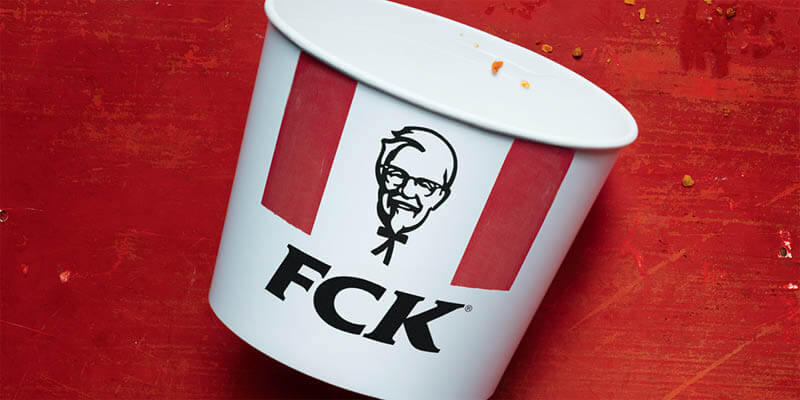
Brand personality has been an invaluable tool for strategic brands to close the gap to their consumers and meet them on the digital front lines of social media.
These brands have a human voice.
Not a loud one that dictates terms and shouts directions.
But one that displays familiar characteristics, shared language and common beliefs their audience are attracted to.
These brands aren’t looking for transactions; they’re building relationships and using personality to do it.
Modern Brands Blur The Brand-Consumer Lines

I’m delighted to say, the days of businesses communicating like a faceless corporation are all but gone.
Apart from some industries where “dry as toast” language is expected (such as insurance and finance), most markets and modern brands have a different feel to them.
They engage, they chat, they feel real and consumers find it much easier to develop feelings and then loyalty towards them because of this.
Let’s take Chubbies as an example.
Chubbies is a shorts brand…
As in a brand that sells shorts? … Yep
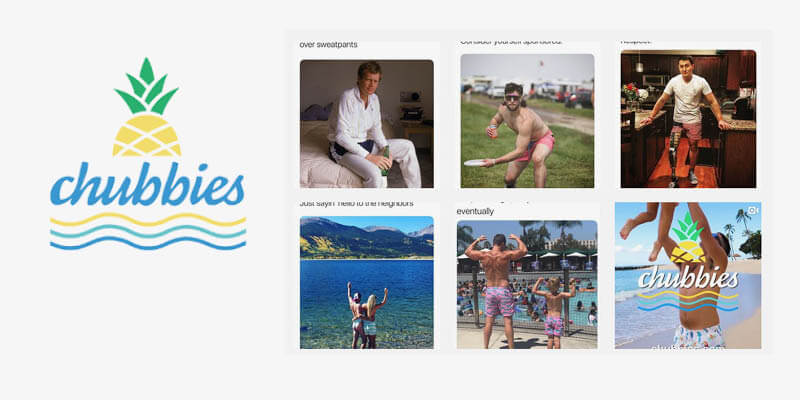
Chubbies has authenticity and diversity at the forefront of their communication strategy and pushes brand personality to the cutting edge.
How?… By treating their customers not as customers, but as friends.
Founder Tom Montgomery said;
“We really built the brand around our customer as our friend. It really is a consumer community building this brand rather than our 50 employees in San Francisco”
They use beer belly customers as models and their instagram page feels like a private whatsapp group of lifelong friends.
This shows that he is a firm believer in treating your brand like a person to better connect with your audience. He said:
“People are constantly trying to keep the conversation fresh and genuine between each other, and that’s the same type of interaction they want to have with a brand.”
This is an example of a modern brand that just “gets it”.
They’re authentic to the core, they let it all hang out and their tangible personality is an example that brand builders around the world need to take note of.
Chapter #4
The Scientific Personality Framework
When it comes to developing a personality for your brand, you can go about it two ways.
Way #1:
Identify a handful of aspirational characteristics and shoot them in the general direction of your audience.
Way #2:
Use scientific archetype framework to identify the personality type of the audience and the most likely personality type they’re attracted to.
I’m no scientist, but if I can leverage the benefit of science to build my brands or not, I’m building scientific brands every day.

What Is A Brand Archetype
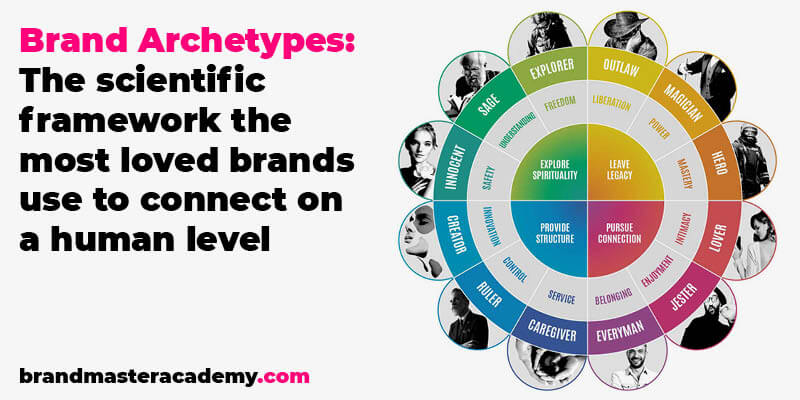
Almost all brands you feel an emotional bond with are built with a solid alignment to a brand archetype.
But what exactly is an archetype?
Let’s break it down.
As humans, we all have basic human desires that are instinctive and primitive.
Yes, that includes sexual attraction but our complex make up means we crave for much more than just physical intimacy.
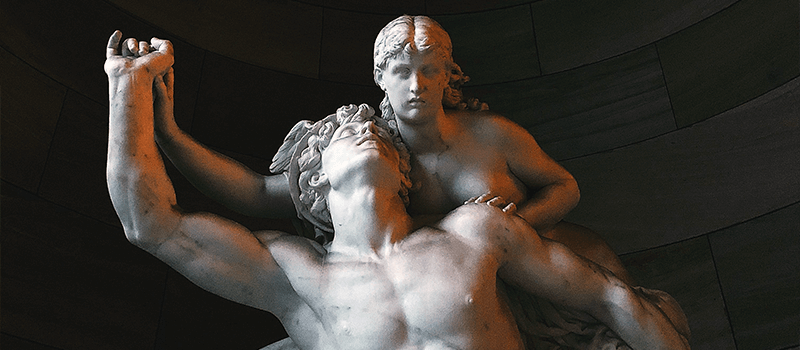
There are 12 core human desires, which vary from one person to the next.
The core desires we have, determine the characteristics we display and these specific groups of characteristics are what makes up each of the 12 archetypes.
Here are the 12 core desires and the aligned archetypes.
Liberation [The Outlaw]
Power [The Magician]
Mastery [The Hero]
Intimacy [The Lover]
Enjoyment [The Jester]
Belonging [The Everyman]
Service [The Caregiver]
Control [The Ruler]
Innovation [The Creator]
Safety [The Innocent]
Understanding [The Sage]
Freedom [The Explorer]
Chances are, one or two of these desires will give you a rush of blood more than the rest…
And this is the point…
We’re all different and therefore we feel different levels of these core desires.
You might have a burning passion for innovation while I might crave belonging.
The truth is, certain behaviours and characteristics increase certain desire levels, which helps us understand why we like some personalities over others.

Archetypes are the personifications of a group of characteristics that appeal to specific core desires.
When we know what our audience desires most, we can determine the characteristics that attract them most.
Why Are Archetypes So Effective?
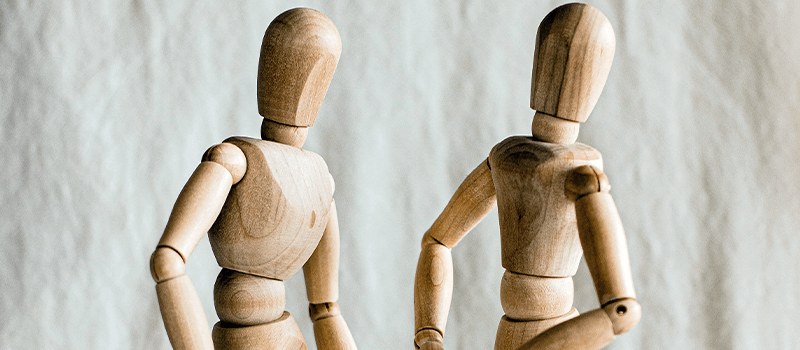
Archetypes characterise universal patterns of behaviour that we all have an instinctive understanding of.
In part, we understand these behaviours because we’ve seen them time and again through story, art, religion and myths.
Another reason they’re recognisable is because of our innate understanding of them.
In other words, we’re all born with an understanding of these patterns of behaviour because they’re pre-programmed into our brains.
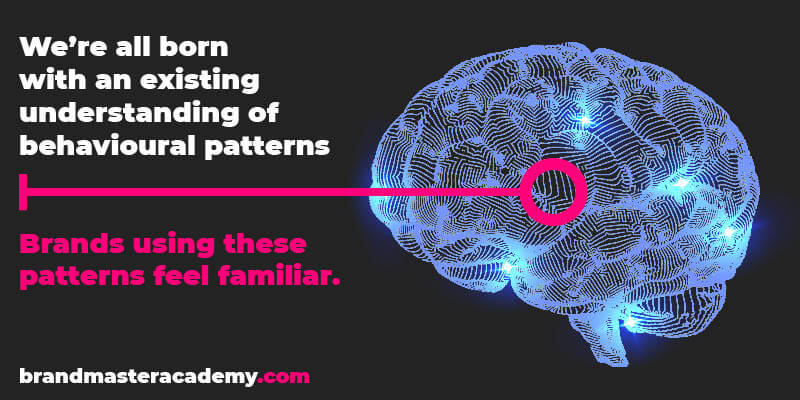
This is hugely advantageous for brands that understand archetypes and develop a brand personality around them.
The 12 Brand Archetypes
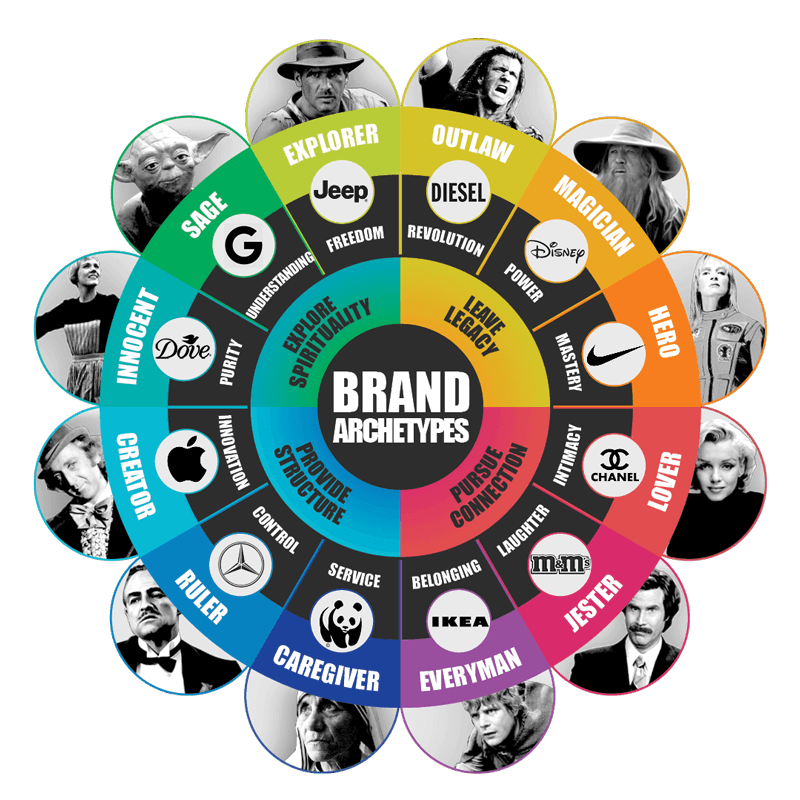
Here are the 12 brand archetypes, their desires, fears, characteristics, philosophies and some of the iconic brands leveraging them.
The Outlaw Personality
The Outlaw is a rebel and they don’t like rules.
They tend to go against the grain of the constraints of modern day society and any form of regulations will be met with distain.

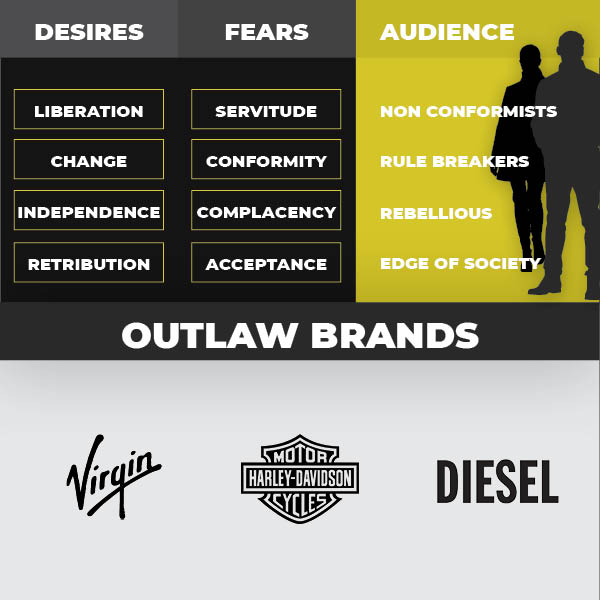
The Magician Personality
The Magician is full of mystique and has the ability to take others on transformational and magical journeys.
They take pride in their vast knowledge and abilities and though they’ll happily demonstrate their prowess, they’re secretive about their processes

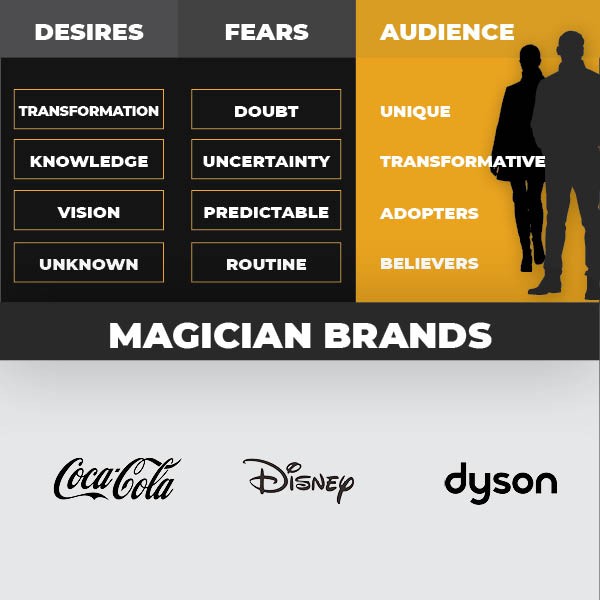
The Hero Personality
The Hero wants to win and be the best, but the desire to demonstrate courage and determination is just as strong.
They would gladly give up the gold medal if they were seen to have sacrificed it.
To them, it’s not the medal that matters, it’s to be recognised as the best.

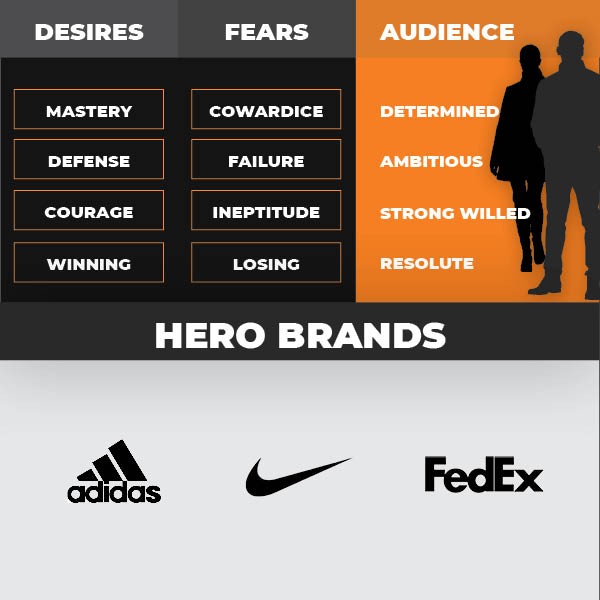
The Lover Personality
The Lover wants to be wanted and preferably to be desired.
They’re driven by intimacy and closeness and have a weakness for sensual pleasure.
They want to be noticed and fear being lonely and unloved.
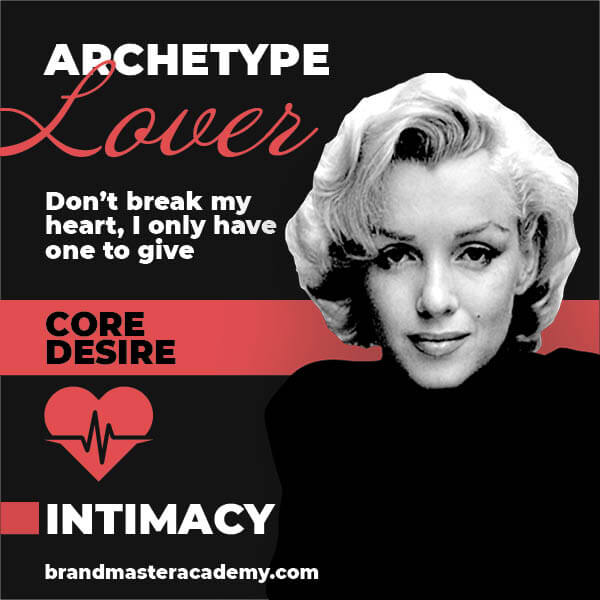
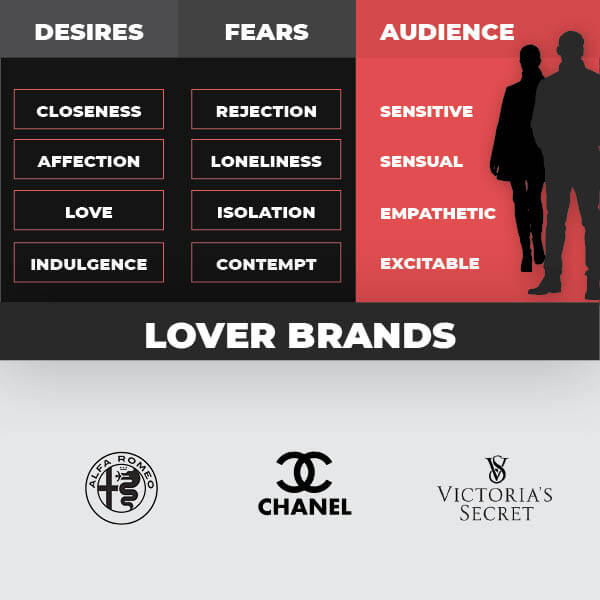
The Jester Personality
The Jester is a fun-loving entertainer with a big heart.
As much as they love having fun themselves which they display in their behaviours, they’re driven by a desire to make other people happy through laughter and entertainment.
They’re young at heart and remain a child at heart throughout their lives.
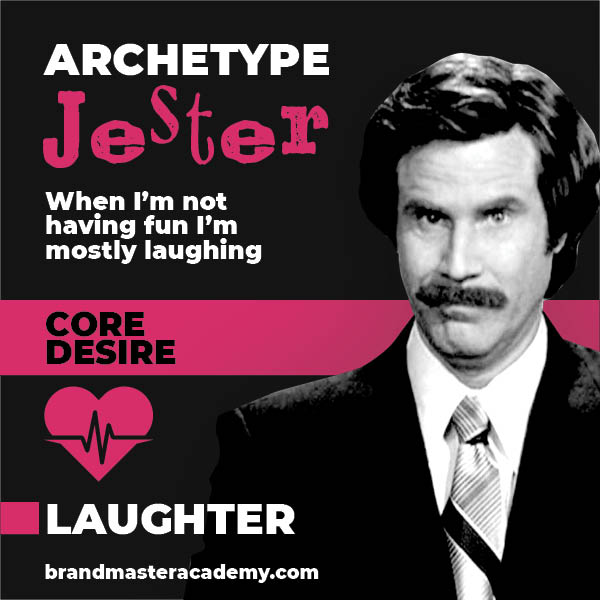

The Everyman Personality
The Everyman is the most “normal” person of the group.
They don’t like to stand out, they don’t look for attention and want more than anything to just belong.
They don’t see themselves as better than others, and dislike those who do.
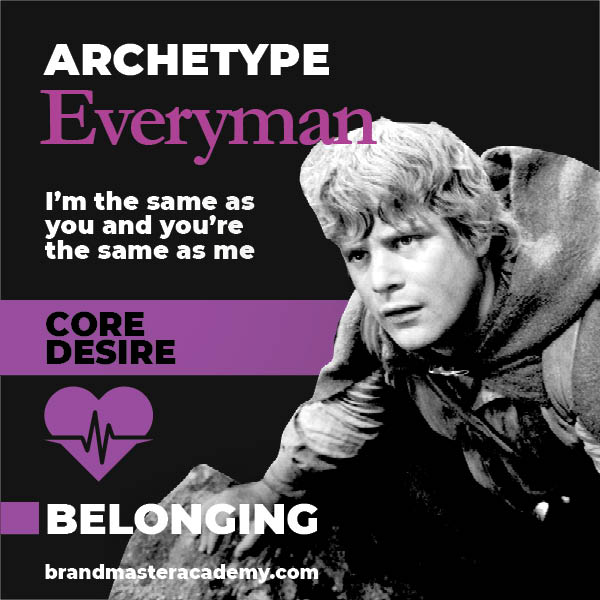
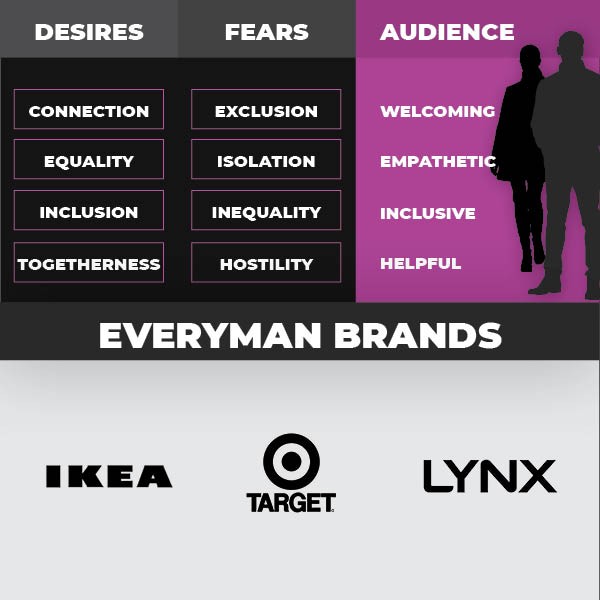
The Caregiver Personality
The Caregiver is a warm personality who lives with a vocation to help those in need of help.
They’re selfless people and would happily give up (and often do), other benefits of life to give service to others.
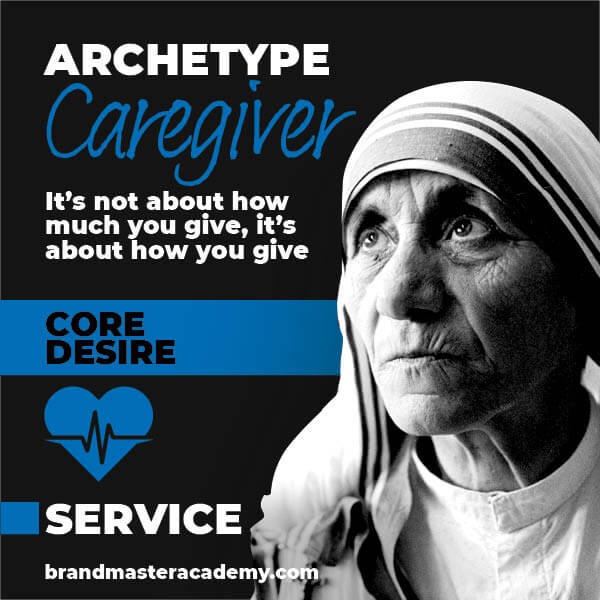

The Ruler Personality
The Ruler has a strong desire for power and control.
They’re a dominant personality driven by status and prestige and see themselves as the top of the ladder of modern day society.
They have a desire for success and achievement and the finer things in life that come with it and are aggressive in their pursuit of it.
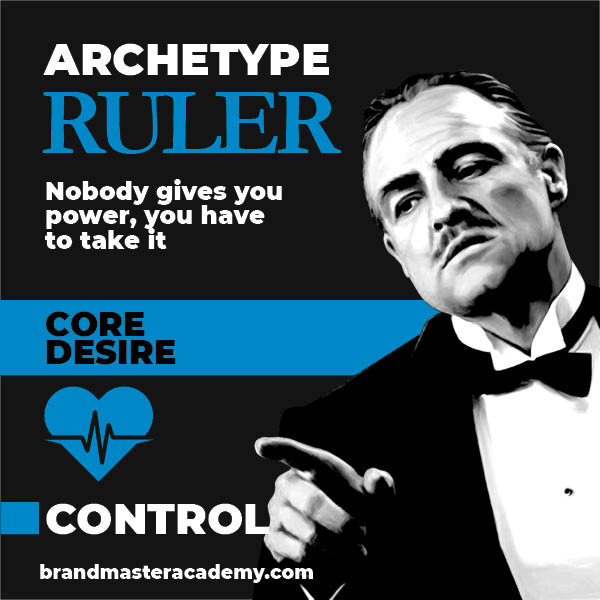

The Creator Personality
The Creator is an innovator driven by the desire to create something original through their imagination.
They are highly self-critical often to the point of insecurity.
Creators are of the belief that if it can be imagined it can be created though their efforts are often sabotaged by their desire for perfection.

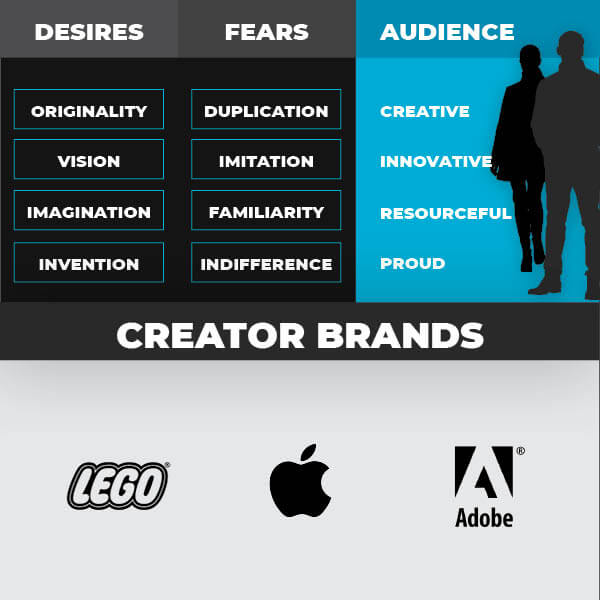
The Innocent Personality
The Innocent is a wholesome personality who has a strong connection with earth and nature within it.
They’re honest and driven by the values they hold dear. They display their values through their behaviours and the lives they lead.
Ultimately they crave safety. They want to feel like they and the world they live in are protected.
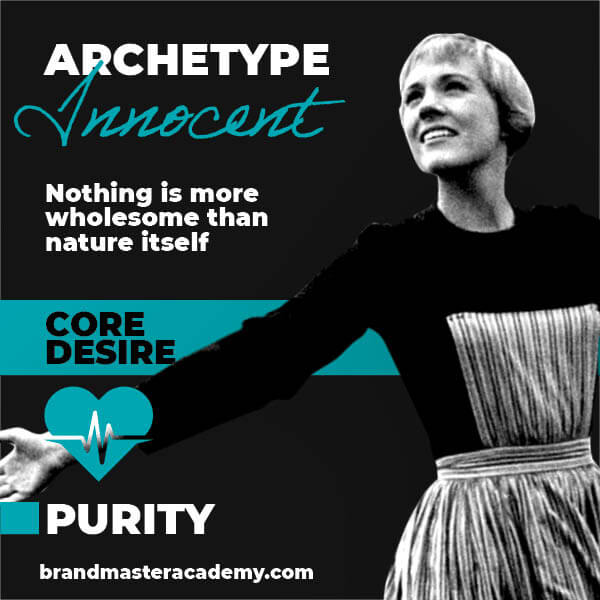
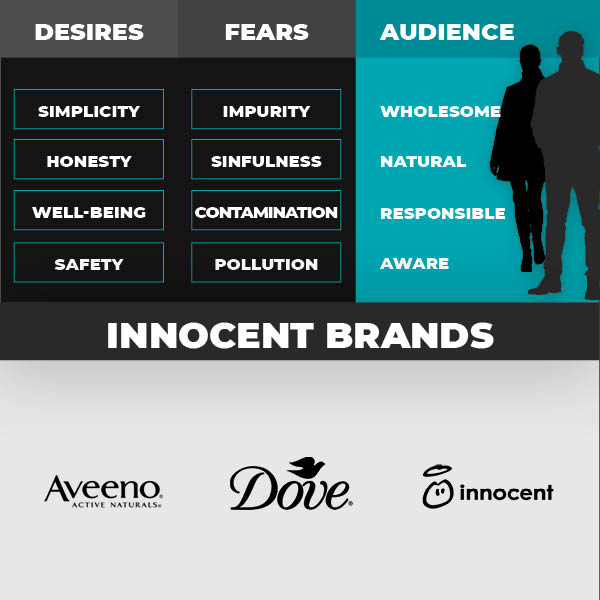
The Sage Personality
The Sage lives for knowledge and is on a never-ending pursuit of wisdom.
They’re life-long learners and want to understand the world and as much in it as deeply as possible.
Their drive comes not from the knowledge itself, but their capability to pass that knowledge on to others so they too can become more enlightened.

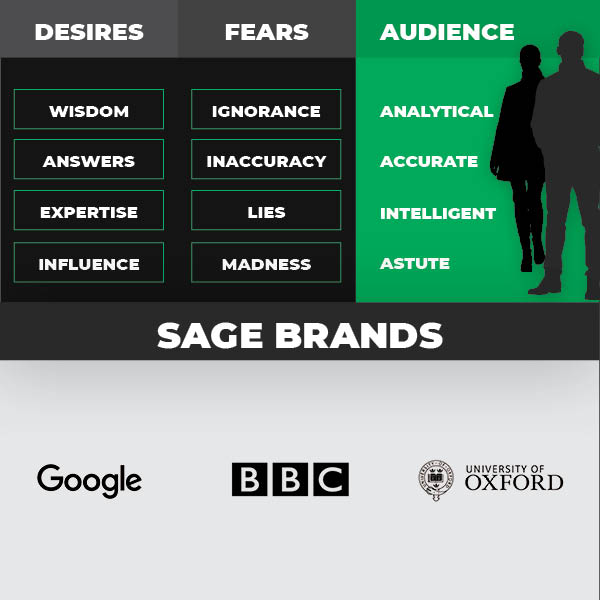
The Explorer Personality
The Explorer personality much like the innocent has a love for nature.
But rather than having an affinity for purity, they desire more than anything to immerse themselves in nature and the outdoors.
An Explorer is happiest when they escape the metropolitan hustle and bustle for the tranquillity of natural landscape and the elements within it.


Chapter #5
How To Create Brand Personality
Before a brand can display a human personality to its audience, it must first be developed.
This is not simply a case of cherry picking a handful of characteristics.
Careful time and attention must be paid to understand the audience, their desires and the traits they’re attracted to before we can strategically develop a personality that will attract them.
In this chapter, we’ll walk step-by-step through the brand personality development process.

Step #1
Identify Your Audience Archetype

Throughout the development of your brand strategy, you need to take the time to understand your target audience.
By using demographics and psychographics you’ll be able to get a broad based idea of what your audience looks like, but to truly understand them, you need to find out what makes them tick.
The behaviours and characteristics your audience display are the ingredients you’re after.
These will help you to align them to one of the 12 brand archetypes, which will highlight their core traits, fears and desires.
Step #2
Identify Your Brand Role
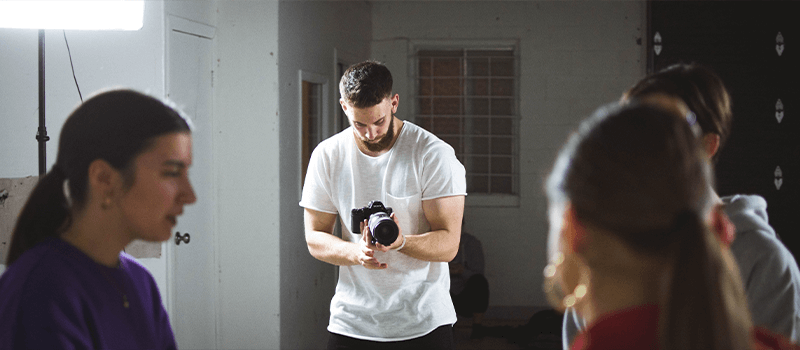
The role you play in the life of your audience is influential in determining the most suitable archetype for your brand personality.
Based on the outcome you provide your audience and the journey you take them on to get there, define what role you will play in their lives.
Are you going to be their:
Guide
Confidant
Mentor
Friend
Leader
Guardian
Protector
Teacher
Partner
Inspiration
Aspiration
Motivator
When you know the role you play in the lives of your audience you’ll have a better understanding of the characteristics they’ll respond to.
Step #3
Align Your Brand To An Archetype

At this point, you understand some critical information to allow you to align your brand to an archetype personality.
You understand
Who your audience is
The journey they’re on
Their fears & desires
Their characteristics and Behaviours
The role you want to play in their lives
Now, you need to begin to make some decisions based on this information.
Study each of the brand archetype personalities, their traits, fears and desires to define which archetype is best suited to playing the defined role of your brand to your brand’s defined audience.
Step #4
Add An Influencer Archetype

Now you’ve defined an archetype that will best represent your brand, you must now take the time to “soften” this archetype with an influencer archetype.
The influencer archetype allows you to shape the personality and behaviours of your brand archetype by introducing complimentary traits your audience is attracted to.
This is not a necessity as your primary archetype might already be a perfect fit to appeal to your audience’s personality.
It can however, be an opportunity to add further dimension to your personality and make it more tangible.
Step #5
Bring Your Human Brand Persona To Life

Your brand personality comes to life as your Human Brand Persona.
At this point you have an archetype framework you can build your brand personality from, though it’s not yet a defined personality.
You understand the traits and characteristics you now want your brand to display but it won’t feel real until it’s truly unique.
In order to do that, you need to adopt attitudes, beliefs and opinions that turn a cookie cutter personality into a truly unique persona who know what it is and where it’s going.
Another useful technique to help bring your brand personality to life is to make it visual.
Use a series of pictures or a mood board to capture the brand personality you’ve developed so it begins to look and feel like a real person.
Step #6
Define Your Brand Voice

When your brand has characteristics, attitudes and opinions to display; it needs tools of the trade to express them.
One of the most expressive tools we have as people is our language and tone of voice.
Its through the language and tone do we really get a feeling for how messages are being delivered.
If you were to receive a text that said, “I had such a great day”, then you’d assume whoever sent it to you had a great day.
If they were being sarcastic because they didn’t have a great day, the only way they could get that message across with those words via text, would be to include an emoji to emphasise how they really feel.

In life we don’t use an emoji, we use our tone of voice because this is one of our most expressive tools as people.
If you’re being sarcastic, I can hear it in your tone of voice.
Once we’ve identified the characteristics we want to display, we must then define the tone of voice and language that will support those characteristics.
When your characteristics, behaviours, opinions and brand voice all align, your brand personality becomes the human persona that will act as the person your audience turns to.
Chapter #6
How To Express Your Brand Personality
By now, you’ve done plenty of development work to bring your brand to life.
You’ve got a brand personality built on a scientific personality framework with traits, attitudes, opinions and a visual presence to boot.
This is an extremely useful tool when it comes to expressing your brand in the market to appeal to your audience.
That said, unless you use it effectively to express your brand, your work would be in vein.
In this section I’ll show you step-by-step how to wield the sword you’ve just forged.

Step #1
Apply Brand Personality To Brand Message
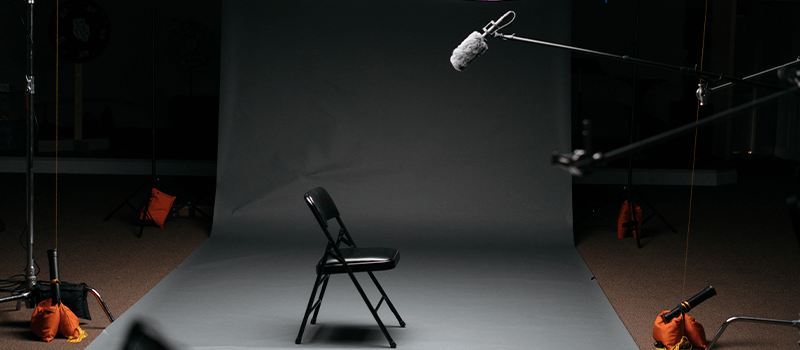
Some brands are built with video content through their Youtube channel or self-hosted content.
This is one of the easiest ways to get your personality across, especially if you’re a personal brand.
If you want to see a master of persona brand personality, check out Casey Neistat’s Youtube Channel
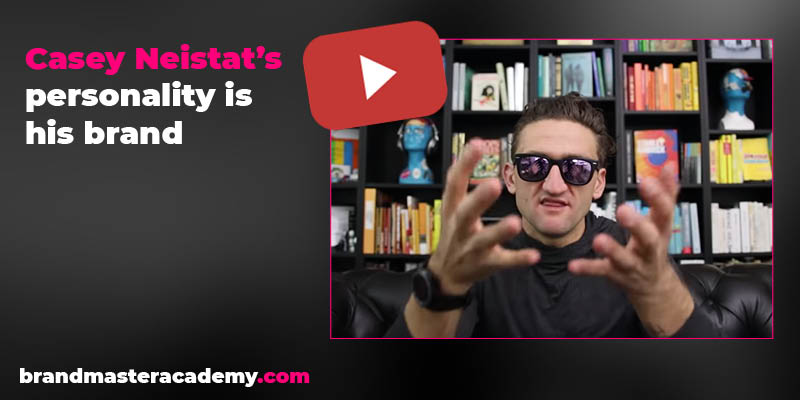
For most brands however, the personality they use won’t have such a platform and will need to be delivered through their written and visual communication.
A well developed brand personality however, is a very effective tool and can transcend a variety of media so the communication “sounds” and “feels” human even though it’s made up of words.
Have you ever read a book, where you were able to “feel” the personality of the author, whether they were serious and authoritative or sarcastic and funny?
Brand personality and effective copywriting go hand-in-hand and that’s where you need to start.

Whether you write copy yourself or use a copywriter to do it, ensure they have your Human Brand Persona in front of them.
With this tool, you can inject very specific language, characteristics and tones that display the personality you’ve scientifically developed to appeal to your audience.
If your personality is effective enough and your copywriter uses it correctly, you’re audience will feel the personality of the brand through every word that’s written.
Step #2
Apply Brand Personality To Brand Story
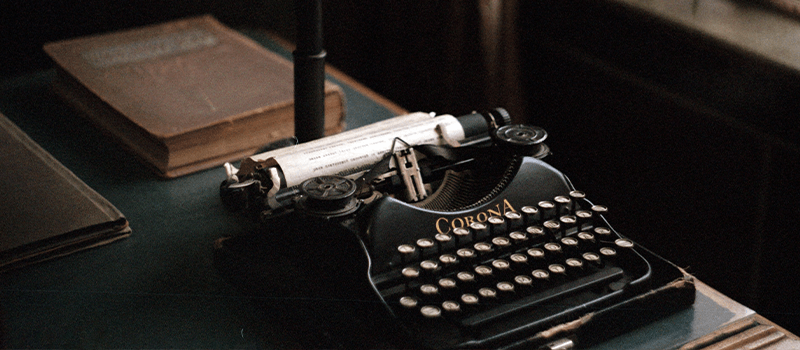
Your brand story is not about your brand.
It’s not about the founders, where they’ve come from and where they want to go.
The reason we love stories is because we can see ourselves in them.
An effective brand story is about your audience, their existing world, their challenges, obstacles, pain points and ultimately their journey to their idea of success.
This is the story your audience wants to hear and this is the story your brand needs to tell.
If you want to learn more about the science behind storytelling, Uri Hassans Ted Talk “This Is Your Brand On Communication” is not to be missed.
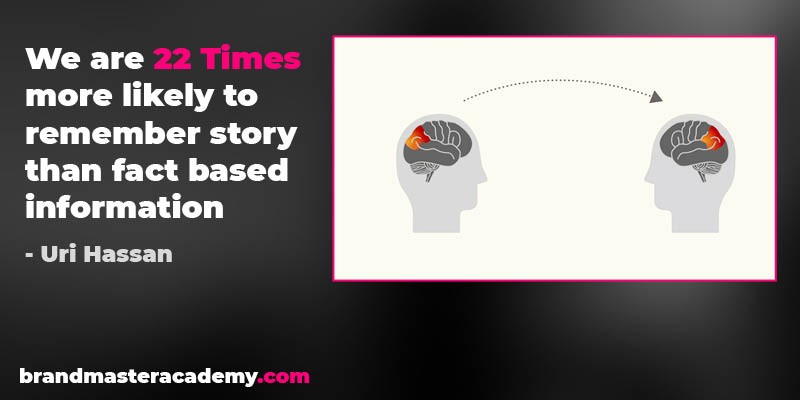
Now you’ve developed your audience persona and your human brand persona, you have the two main characters of the story who will make the journey together.
As you tell it, ensure the traits of both characters come across to read like a John Grisham novel.
Step #3
Apply Brand Personality To Brand Identity
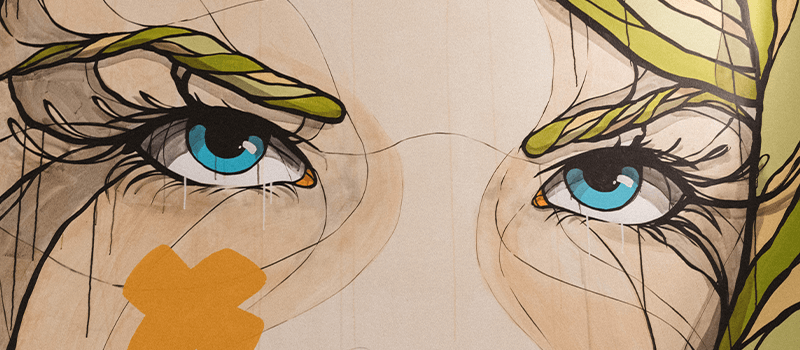
Your brand identity is one of the most expressive tools of the entire brand strategy.
As people, we can remember visuals having seen them for as little as 13 milliseconds or 0.0013 of a second.
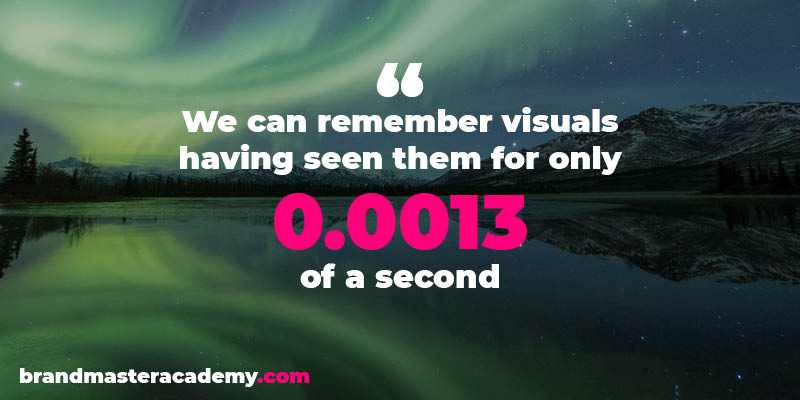
This is because because our reptilian brain processes visuals, which is designed to help us to quickly identify dangers and threats, so we don’t get eaten by a predator.
The characteristics you want to display through your brand personality can be applied very effectively through the visuals you develop.
Characteristics Of Image Style

The image style is one of the most recognisable and memorable elements of the entire brand identity system.
It’s a tool you can use to display specific actions, attitudes and opinions through specific characters, scenes, filters, moods and visual tones.
Characteristics Of Colour Palette

Colour plays an important role in the feelings and emotions you want your brand to be associated with.
If your personality is rough and gritty then dark and earthy tones could portray these characteristics.
If on the other hand your personality is light and fun then yellows or neutrals would allows you to communicate those traits.
If you want to dive deeper, this Infographic we created was featured by Hubspot
Characteristics Of Typography

Typography comes with its own distinct characteristics.
Unless you’re designing a custom type for your brand, then you’ll need to carefully align your brand personality with a typeface that most accurately displays those characteristics.
For example:
If your personality should display sophisticated and modern traits, then a thin sans serif font would help to communicate those characteristics.
If on the other hand your audience is attracted to nature or earthy wholesomeness, then a more natural handwritten font would be more appropriate.
A well-developed brand personality with aligned with the right typography, doubles down on the characteristics your audience is attracted to.
Step #4
Apply Brand Personality To Every Touch Point

Your brand strategy sets the foundation of all of your brand communication.
While your copywriters and designers will inject your brand personality throughout the development of your brand, it’s important that this personality is displayed consistently.
Your marketing efforts are the front lines of your brand and where your personality needs to be at its most tangible human self.
Every touch point should be laced with your brand personality including your:
Website
Brochures
Banners
Content
Videos
Social Channels
Social Posts
Emails
Lead Magnets
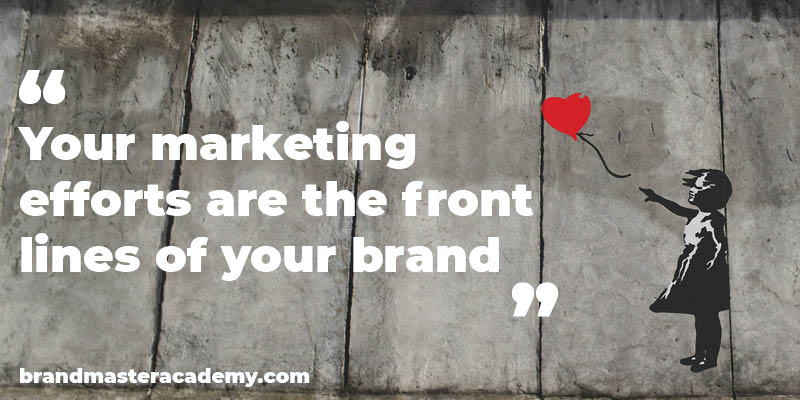
A brand is an entity that humanises a business so the intended audience can develop feeling towards it and ultimately a relationship with it.
As in life, you never get a second chance to make a good first impression so ensure every touch point meets your audience with the personality they’re most attracted to so you start the relationship off on the right foot.
Chapter #7
Brand Personality Examples
As we’ve covered, some of the most loved brands in the world have been build on their ability to connect with their audience on a human level through their personality.
In this chapter, we’re going to take a look at how the big boys do it.
So sit up and take notes because this is a lesson on brand personality execution.

Brand Personality Example:
Harley Davidson

Harley Davidson is an absolute master when it comes to executing brand strategy.
Yes, they have the added advantage of their masterpiece of a motorbike when it comes to their visuals.
But where Harley set themselves apart is through how they display their characteristics at every single touch point whether that touch point visual or not.
Their language and tone is expertly used to resonate with their audience through their rebellious spirit.
They point to the confines of modern society as the enemy and speak to their audience’s inner child.
Here are some of the characteristics Harley displays throughout their touch points.
Brand Identity: Rugged
Language: Gritty
Tone-Of-Voice: Rough
Characteristics: Rebellious / Disruptive
Their Motivation: Liberation
Their Fear: Conformity
Brand Personality Example:
Red Bull

Red Bull’s personality can be summed up in a single word:
Extreme
As their product is positioned around offering a boost of energy, their alignment to extreme sports is a perfect match.
Sport involving danger is synonymous with a rush of adrenaline and their visual and language play the “extreme” tune with a perfect pitch.
Here are some of the characteristics that represent Red Bulls brand personality:
Brand Identity: Edgy
Brand Language: Energetic
Tone-Of-Voice: Caffeinated
Characteristics: Extreme / Outrageous
Their Motivation: Adrenaline
Their Fear: Calm
Brand Personality Example:
Dove

Dove is an elegant brand that lives by its purpose and values.
They represent The Innocent Archetype beautifully by aligning themselves with the word “Purity”.
They offer their female audience godlike status and they promote the beauty and femininity in all women.
Their personality is positive and encouraging and they promote honesty and respect.
Here are some of the characteristics that represent Dove’s brand personality:
Brand Identity: Pure
Language: Simple
Tone-Of-Voice: Positive
Characteristics: Purity / Honesty
Their Motivation: Self-Esteem
They Fear: Shame
Chapter #8
Brand Personality Execution
At this point, you’re ready to go.
You’re oozing personality at every touch point and the characteristics you’ve identified to enhance your audience’s attraction are seasoned throughout your brand communication.
But what now?
What do you do going forward?
In this chapter, we’ll look at some tips to keep you charming.

Consistency Is Key

When it comes to displaying your personality its critically important that it remains consistent.
Have you ever met someone that you didn’t like, but you couldn’t put your finger on why?
That’s because your reptilian brain analysed the characteristics they displayed and made a decision about them before your neocortex (you logical brain) could figure out why.
The point is, whether they’re conscious about it or not, your audience is analysing your brand for inconsistencies.
It’s not because they doubt you, it’s what the brain does by default.
If an inconsistency is found, whether in the messaging, the personality or anywhere else throughout the brand, it will be spotted and the trust will be lost.
Use The Appropriate Personality Level
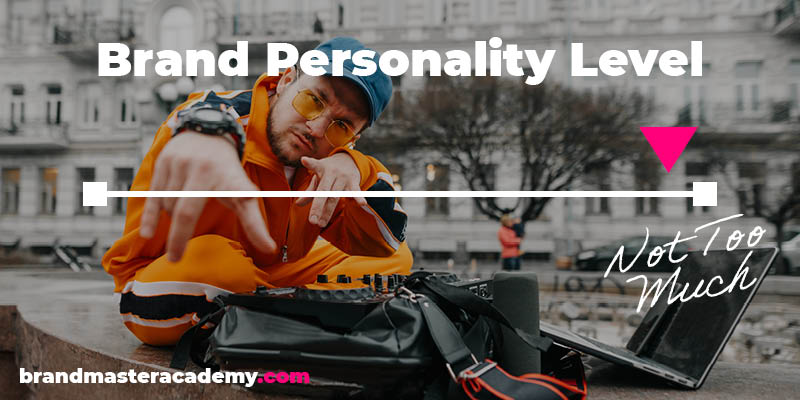
As people, we might be attracted to others with a good sense of humour and make us laugh.
If however, they’re “over-the-top” and do nothing else than try to crack jokes, we’ll be completely put off.
Personality is an effective, but it needs a sensor adjustment.
When injecting personality into your brand communication and experience, ensure you’re using the right level for your audience.
Too little and it will go unnoticed, too much and you’ll scare them off.
All Brand Building Efforts Must Be Aligned

Within your brand, you may be operating as a solopreneur who wears all the hats.
But as you grow, more people will come in to your business and it’s imperative these people are armed with the Human Brand Persona.
Whether it’s a designer, copywriter, social media manager or content creator, its critical you take them through the inner workings of your brand.
This is especially true if they’re creating any form of communication for the front lines of your brand, which are your marketing efforts.
Only when all brand representatives are singing from the same hymn sheet, will your brand be consistent.
Conclusion
We live in the age of the Human Brand.
Your brand needs to show up as a human entity your audience can resonate with and build a relationship with.
Personality is by far the most effective brand strategy tool to humanise your brand.
First, use a proven framework to develop one.
Second, show up to your audience consistently with that personality.
Third, build human relationships and build your Brand.
Now over to you…
Are you building a brand for yourself or a client?
Has this article given you food for thought or the tools to build your personality?
Do you have any challenges at all around brand personality?
Let me know in the comments. I’d love to hear from you.
On-Demand Digital Program
Brand Master Secrets
Make the transition from hired-gun to highly valued brand strategist in less than 30 days. The systems, frameworks and tools inside this comprehensive program are all you need to level up.









Hi Great article. So if I understand you correct I should use archtypes on my customer and communicate theris, and not just mine?
No, you identify their archetype in order to better define yours… Then using your archetypes, you flesh out your brand personality
Brilliant article! very valuable content. Thank you.
The next one, Alternate Positioning, is completely customized for the client, based on the research and in-person discussions we have during the branding process. For those of you following along and completing these exercises for your own brands, this is your opportunity to push the boundaries. No limits, no formula, just say what you can prove and live in the biggest, most audacious way possible. Consider the benefits to the client of working with you, consider if you can say we are the “leader” in anything, consider the excitement you want your clients to feel when they read your positioning statement. Go crazy and have fun, this one’s all you!
Hi , the free Brand Blueprint Strategy download link doesn’t seem to be working. Regards Kingsley
Sorry to hear about that… please try this link – https://brandmasteracademy.com/brand-strategy-blueprint/
Brilliant!! Thanks!! :-=